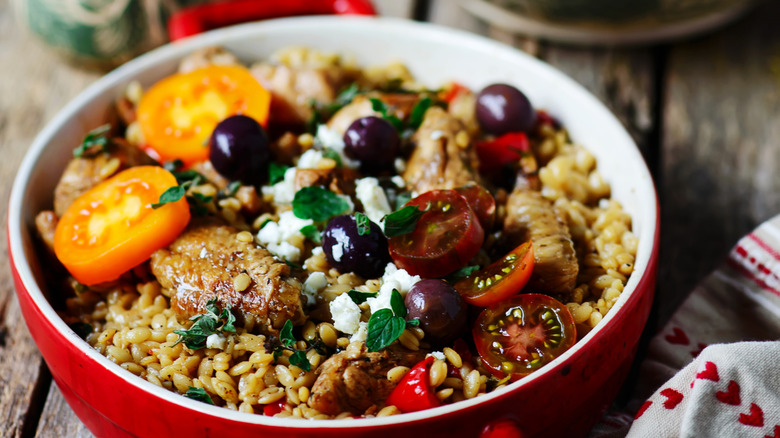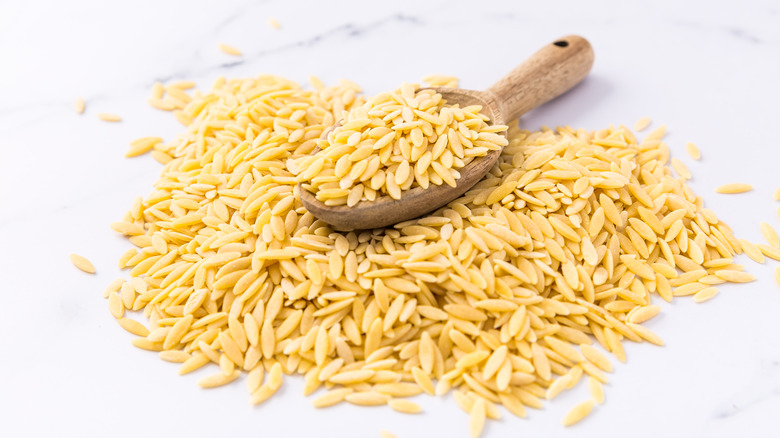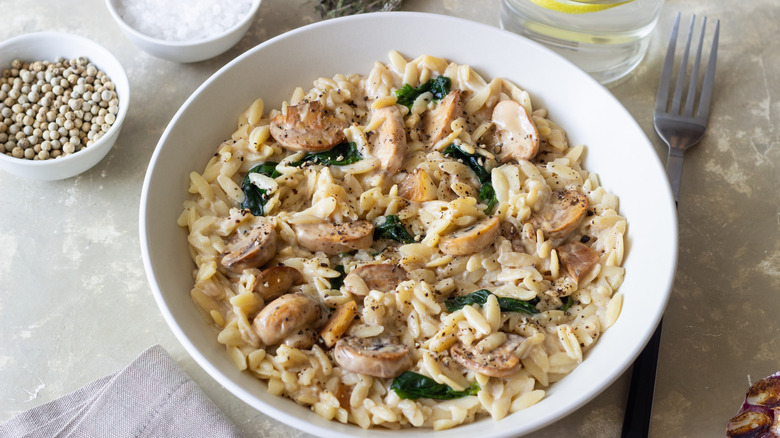No, Orzo Isn't Rice. So What Is It Exactly?
Few foods are more globally popular than rice, hence its appearance in cuisines worldwide. Found in forms ranging from sticky sushi to crunchy paella, its composition is expansive. As a result, it can become tricky delineating what's a rice variety. Grains like bulgur, buckwheat, and farro all possess similar texture, yet aren't included in the rice umbrella. And then there's orzo, which looks nearly indistinguishable, but also isn't rice.
Yes, despite the food's small, grain-like elongated shape, it's actually a type of pasta. Since it's made from wheat, that means it's high in gluten, a vital consideration for diners with sensitivities. Furthermore, the way orzo and rice are prepared differ, too. The former's boiled in water, and can even be added to soup, while the latter's steamed. So, when you're reaching for a package, it's clear you don't want to mix up the two foods. But keep designated culinary techniques in mind, and you'll be able to turn orzo into a delicious stress-free dinner.
Rice-shaped orzo is a type of pasta
Orzo is in the pastina category of ultra-small noodles. It's made from semolina flour, which lends it a vibrant yellow hue. The flavor's on the gentle side, similar in palate to other pastas. However, its texture is distinct — the noodles boast a soft and tender consistency that's privy to sticking together. As a result, orzo's nearly always served with oil, a sauce, or in a soup, which is a traditional Italian preparation. The pasta's an excellent way to make dishes like a basic tomato and herb vegetable soup extra satiating.
Generally, cooking the orzo is similar to other pasta types. The food is simply boiled in salted water for around eight to 10 minutes. Unlike other noodle varieties, orzo doubles in its volume when cooked. As a result, you'll need to keep a more careful eye on the initial volume you throw in the water.
In part, orzo's confusing categorization arises due to its nomenclature. In Italy, the pasta is called risi, meaning rice. Orzo is instead the Italian word for barley, another grain that bears a strong visual resemblance. The name orzo was likely first attributed in the U.S. Additionally, you'll find the product in Greece by the name kritharaki. So, keep a close eye on what's on the label to ensure you grabbed the right pasta type.
Substitute orzo into a handful of rice dishes
The flavors and textures of rice and orzo aren't an identical match. You wouldn't want to prepare the pasta like a basic steamed white rice. Orzo is much smoother in texture, with a less kernel-like consistency. It's prepared to an al dente state with a gentle bite. So, unlike rice, there's less stickiness. Typically, you wouldn't want to substitute the two foods. Nevertheless, with the many potential rice preparations, there are creative ways to craft substitutions.
One option is to replicate starchier rice dishes like risotto. Since the utilized arborio rice has a starchier composition, orzo can replicate risotto's distinct creamy texture. Just make sure to adjust for the pasta's volume expansion, so keep an eye on the amount of broth added to the cooking vessel.
Alternatively, replace orzo in liquidy rice dishes. The pasta will substitute well in a soup with rice, whether it's a Chinese-style rendition or simply a swap into a chicken soup. Or try out a Portuguese-style rice dish with orzo, in a preparation like a monkfish rice stew. What's key is that the dish maintains a good amount of liquid to help the orzo not stick, and make the transition from rice to pasta more seamless.


